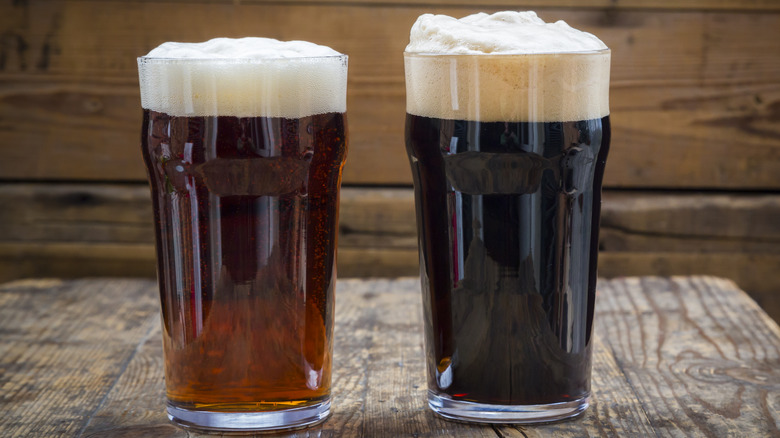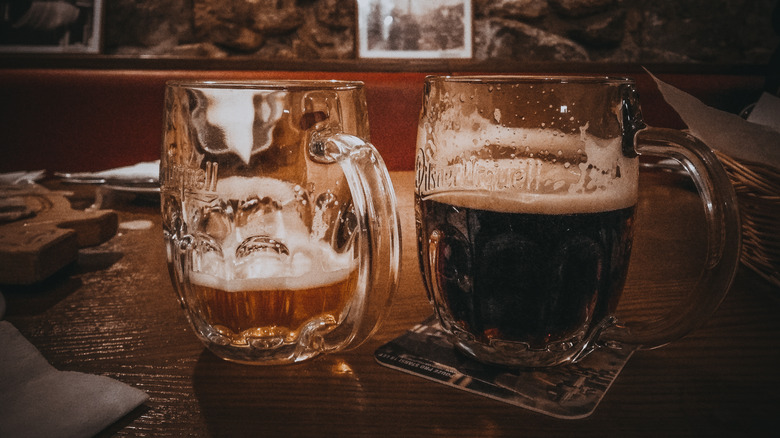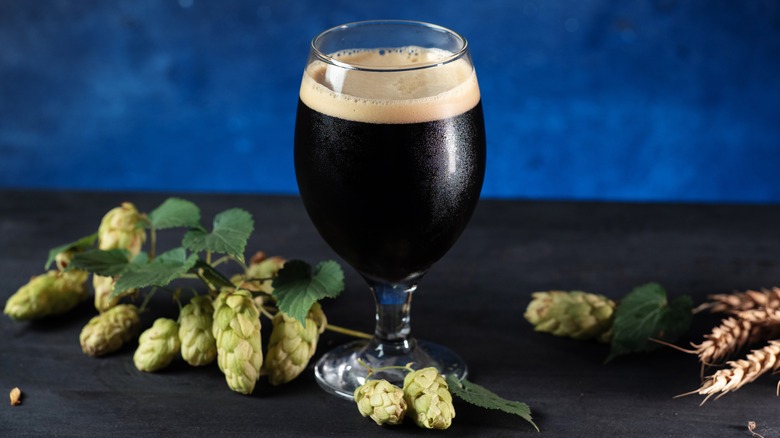Porter Vs Stout: What Makes These 2 Beers Different?
With the kaleidoscope of flavorful beers available today, walking through the adult beverage aisle looking for a specifically dark brew can get confusing. American stouts often sit right next to Irish porters on the shelves, flanked by oatmeal stouts and Baltic porters, but their labels don't necessarily convey what they taste like. Even if you were to try both at the same time, identifying the difference between a porter and a stout isn't as easy as distinguishing the contrast of a hoppy IPA to a pilsner or similarly flavored Kölsch.
The main disparity separating the two comes down to the type of barley used in the brewing process. When porters are brewed, malted barley is responsible for their toasty chocolate aroma. Stouts use roasted, unmalted barley that imparts darker, dryer notes more akin to coffee for their makeup. As the name suggests, stouts are typically more robust in flavor and have higher alcohol content than their smoother cousins.
The divergence of two beers
Porters first gained favorability in England in the early 1700s , coming to share the name of the workers toiling at the port. These dock-working laborers adored the brew so much they would sometimes sneak a taste from casks they were transporting by sticking a straw into the side and having a sip, an action amusingly referred to as "sucking the monkey." However, it wasn't long until folks desired something stronger.
Stout porters soon emerged as a bolder version that used less water to give them more oomph, but during the mid-19th century, the recipes began to deviate further. Over the next century, manufacturers across the globe were producing their own distinct recipes that gave way to the various sub-genres that exist today. While English porters are often brown and have a distinct nutty malt taste, American porters are often darker and less sweet with a more noticeable presence of hops, which gives beer its bitter flavor.
Stouts vary between Irish, American, milk, and oatmeal variations – all with unique flavor profiles derived from various adjuncts used to flavor the beer. Neither dark beer is overly hoppy, though as stouts have evolved, some brewers have started using more to give the beer more floral and spicy notes.
Each beer's sub-genre has a unique appeal
Porters range in texture and flavor depending on the sub-genre. Brown porters are usually sweet and nutty, more in line with the traditional English variety. Baltics generally have higher alcohol contents with a smoother texture and milder malt flavor than other variations due to the amber and brown malts used when brewed. Robust porters boast a fuller body than a brown with the addition of black malts that showcase notes of coffee and chocolate. They all exhibit a lighter overall profile than a stout, which relies on adjuncts and roasted barley for its potent flavor.
A milk stout is produced with lactose, a sugar found in milk that doesn't ferment and gives this variety a creamy mouthfeel that balances its pronounced roasted barley flavor. An oatmeal stout presents a silky texture it takes on from its namesake ingredient with a nuttier, hoppier profile that offsets the rich, sweet flavor of chocolate. One of the more robust variations is the imperial, a jet-black beer that is thick going down and often imparts notes of dark fruit with undertones of vanilla.
The differences may be subtle, but beer connoisseurs cherish the opportunity to identify the unique profiles that separate them. From porters to stouts to IPAs and scarcer beers like Westvleteren 12, there's a beer out there for any flavor preference. Craft breweries are still introducing new flavor profiles to aficionados, so there's no telling what sub-genres porters and stouts are coming next.


